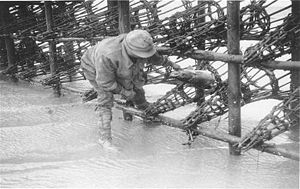
Putcher
Encyclopedia

As a method of fish capture, putcher fishing
Putcher fishing
Putcher fishing is a type of fishing which employs a large number of putcher baskets, set in a fixed wooden frame, against the tide in a river estuary, notably on the River Severn, in England and South East Wales.-History:...
is peculiar to the River Severn
River Severn
The River Severn is the longest river in Great Britain, at about , but the second longest on the British Isles, behind the River Shannon. It rises at an altitude of on Plynlimon, Ceredigion near Llanidloes, Powys, in the Cambrian Mountains of mid Wales...
in Great Britain
Great Britain
Great Britain or Britain is an island situated to the northwest of Continental Europe. It is the ninth largest island in the world, and the largest European island, as well as the largest of the British Isles...
and is believed to be of prehistoric design. Traditionally the putcher was made of hazel
Hazel
The hazels are a genus of deciduous trees and large shrubs native to the temperate northern hemisphere. The genus is usually placed in the birch family Betulaceae, though some botanists split the hazels into a separate family Corylaceae.They have simple, rounded leaves with double-serrate margins...
rods with withy (willow
Willow
Willows, sallows, and osiers form the genus Salix, around 400 species of deciduous trees and shrubs, found primarily on moist soils in cold and temperate regions of the Northern Hemisphere...
) plait, both materials being grown locally on the Caldicot and Wentloog Levels
Caldicot and Wentloog Levels
The Caldicot and Wentloog Levels are two areas of low-lying estuarine alluvial wetland and intertidal mudflats adjoining the north bank of the Severn estuary, either side of the River Usk estuary near Newport in south east Wales...
. Modern baskets made of steel
Steel
Steel is an alloy that consists mostly of iron and has a carbon content between 0.2% and 2.1% by weight, depending on the grade. Carbon is the most common alloying material for iron, but various other alloying elements are used, such as manganese, chromium, vanadium, and tungsten...
or aluminium
Aluminium
Aluminium or aluminum is a silvery white member of the boron group of chemical elements. It has the symbol Al, and its atomic number is 13. It is not soluble in water under normal circumstances....
wire were introduced in the 1940s and 1950s.
Traditional construction
Willow was harvested using traditional methods of pollardingPollarding
Pollarding is a pruning system in which the upper branches of a tree are removed, promoting a dense head of foliage and branches. It has been common in Great Britain and Europe since medieval times and is practiced today in urban areas worldwide, primarily to maintain trees at a predetermined...
, where a tree would be cut back to the main stem. New shoots of willow, called "withies", would grow out of the trunk and these would be cut periodically for use.
To make a putcher by hand, a low bench was used approximately 18 inches (457.2 mm) high and 24 inches (609.6 mm) square into which 9 holes were made, in a circle 10 inches (254 mm) in diameter. Green withy
Willow
Willows, sallows, and osiers form the genus Salix, around 400 species of deciduous trees and shrubs, found primarily on moist soils in cold and temperate regions of the Northern Hemisphere...
or hazel
Hazel
The hazels are a genus of deciduous trees and large shrubs native to the temperate northern hemisphere. The genus is usually placed in the birch family Betulaceae, though some botanists split the hazels into a separate family Corylaceae.They have simple, rounded leaves with double-serrate margins...
rods were then split into three using an oak cleaver held in the maker’s hand. The split lengths were then inserted into the holes to make a conical shape and a withy ring was plaited round them close to the surface of the bench. Nine shorter rods, either complete or in thirds, were then inserted into the ring, with two more rings being plaited around to secure them, one half way up and another near the top. A nose ring was then plaited. The putcher was then pulled out of the bench, the nose ring attached and a spiral `worm' was added from the narrow end to the middle. A base ring was woven at the end of the basket. Any longer rods could then be trimmed and the basket was ready for use. The basket was expected to last for two fishing seasons, possibly also for a third following repair.

